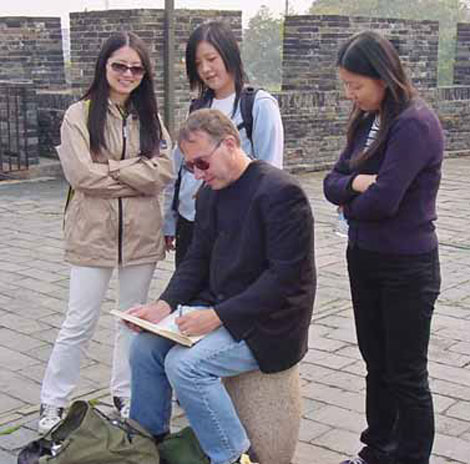Growing together
Updated: 2012-08-31 07:47
By Zhang Lei (China Daily)
|
||||||||
|
Above: Jon Burley gives his Chinese students tips on design. Below: Burley's drawing of Huangshan Mountain in Anhui province. Provided to China Daily |

US professor taps Eastern thought and Chinese gardens for life lessons
Amid a renewed interest in Chinese gardening as it rides on increasing cross-cultural exchanges between East and West, at least one US scholar feels the best way to transplant Asian thought on Western soil is fusion.
Some Chinese experts believe their gardening practices, steeped in Eastern culture and philosophy, will not work in the West, but Jon Burley, associate professor in the School of Planning, Design, and Construction at Michigan State University, cannot see why not, because the quintessential Chinese garden is actually very versatile, he says.
"In many ways, there is no one single Chinese garden style and it ranges from very geometrical to very informal. China is very rich in style and approaches. There are many principles that can be gleaned from Chinese gardens/landscapes that can be applied and may not necessarily be a historically styled garden, but be inspired and applied to a new setting and environment."
Burley says the Chinese garden incorporates many forms and styles, from simple bamboo with a seat in the middle, to a small pavilion or plaza in a natural landscape, to more traditional Ming (1368-1644) and Qing (1644-1911) dynasties' private gardens. Designs include those from Dunhuang in the west to Harbin in the northeast, Guangzhou and Kunming in the south, and across many climates, plant and construction materials, and local traditions, all having evolved through time.
Burley also believes that interest in the Chinese style may not have anything to do with China's rising prominence in the world, but rather with the openness that the country now embraces.
"Learning about China has been closed for a long time from the Qing Dynasty until the last few decades. During that time it was difficult to learn much about China. For example, Westerners know much about Japanese bonsai because Japan has been more accessible and they know little about Chinese penjing, even though Japanese bonsai comes from Chinese penjing and penjing is much older with many variations."
In his university lectures, Burley similarly covers the importance of Chinese penjing and its many styles. Many students say they are fascinated by its history and are happy to learn about Chinese experience.
"I believe global interest in China is much more simply explained than stating that China is rising in prominence; instead it is due to increased access along with China being very interesting to learn about, having much to offer intellectually, and much about China now is very good, often the best. For the past 5,000 years China has always been a great country."
As an international traveler, he has seen how cultures influence each other and develop hybrid ideas. Sometimes he reads Chinese news about concerns that the West is influencing China. Yet Chinese culture for thousands of years has always adopted ideas and technology from the many cultures it interacts with, he says.
"Adopting reasonable and good ideas, and now from the West, is an example of what China has done for thousands of years. Still, during all this time China has always been able to maintain a strong sense of identity. Even if China adopts many ideas from the West, a thousand years from now China will still have a strong identity and culture.
"And while the West influences China, China greatly influences the West. There is much in the West that you see in everyday life that is influenced from China. China has had a great positive cultural impact upon the world. As a Westerner, it has been comforting to see how China has made such a positive impact upon the world."
Burley's interest in China started early. By the time he was 14 he had already written a report on the travels of E.H. Wilson (an English plant collector) in China. Thereafter he did a presentation on the Taklamakan Desert in Northwest China, and wrote a paper about the first years of the "cultural revolution" (1966-76). He has visited many Chinese places, including Kunming, Guilin and Hangzhou.
Recently he has worked with scholars from Nanjing Forestry University to study the gardens of Suzhou and published a research paper, Non-Euclidian Methods to Characterize the Masters of the Nets Garden, Suzhou, China.
Burley has worked with academics and students in many countries, working with French, Portuguese, and Chinese institutions.
"In many respects, we face similar challenges and opportunities. I have been teaching design at the university level since I was 20, 37 years ago, so I have seen many situations and encountered various issues. I enjoy sharing with my colleagues."
Burley has taught almost every subject in landscape architecture, from design to construction, planning, theory, history, professional practice, ecology, social science and natural science. When teaching students, he aims to help them achieve their dreams and ideas. It is often best not to tell them how he would do the project, but instead guide them to achieve their ideas, he says.
"Sometimes students say that my style is very Asian, because I tell stories, give parables, inspire students and do not tell them exactly what they should do. If they just follow my instructions, they have only learned to be dependent upon me, and when I am gone, they must be able to think and achieve for themselves, so I do not make them dependent upon me."
This is why he models his approach after Confucius, Zen Buddhists, Taoists, and the master strategist Zhuge Liang from the Romance of the Three Kingdoms, his favorite book.
"Chinese philosophy has guided me well," he says. "Sometimes students desire to know what they perceive as a secret to design, as though there is some magic to make a design. At times like these I tell them they must have a concept or idea to orchestrate their design. But I will not tell them which concept to use. It is part of their journey to discover which idea or concept to develop. The top designers in Asia, Europe and America excel at creating ideas to explore a design. This is why we have much in common across the world."
Burley's work has been published in English, Chinese and French. He is also a member of the Landscape and Environmental Design Committee, a member of the Landscape International Scientific Committee for the World Scientific and Engineering Academy and Society, and chair of the Land-use and Planning Technical Division of the American Society for Mining and Reclamation.
Besides teaching, Burley has completed 15 sketchbooks of drawings from around the world, dating from 1975. He has painted almost 200 oil paintings and is an avid gardener of hardy magnolias, Northern Lights series of azaleas and dwarf evergreens. He still finds time to play the guitar and piano.
This year he has been on sabbatical in France, supported by the French government, to work with French researchers. Sometimes students or professors jokingly call him an "American Leonardo da Vinci" because of the many hats he wears.
"But I know they are just playing to my ego to see how I will respond. When people tell me that I am great, I know in my heart I am not that good; conversely there are people who desire to portray me as having no talent, and I have the confidence to know they are wrong too.
"It is true that I can seem complex, accomplished, experienced and knowledgeable. But outwardly, I am quite simple.
"Confucius gives me great advice about how to behave as person."
zhanglei@chinadaily.com.cn
(China Daily 08/31/2012 page21)

 Relief reaches isolated village
Relief reaches isolated village
 Rainfall poses new threats to quake-hit region
Rainfall poses new threats to quake-hit region
 Funerals begin for Boston bombing victims
Funerals begin for Boston bombing victims
 Quake takeaway from China's Air Force
Quake takeaway from China's Air Force
 Obama celebrates young inventors at science fair
Obama celebrates young inventors at science fair
 Earth Day marked around the world
Earth Day marked around the world
 Volunteer team helping students find sense of normalcy
Volunteer team helping students find sense of normalcy
 Ethnic groups quick to join rescue efforts
Ethnic groups quick to join rescue efforts
Most Viewed
Editor's Picks

|

|

|

|

|

|
Today's Top News
Chinese fleet drives out Japan's boats from Diaoyu
Health new priority for quake zone
Inspired by Guan, more Chinese pick up golf
Russia criticizes US reports on human rights
China, ROK criticize visits to shrine
Sino-US shared interests emphasized
China 'aims to share its dream with world'
Chinese president appoints 5 new ambassadors
US Weekly

|

|







